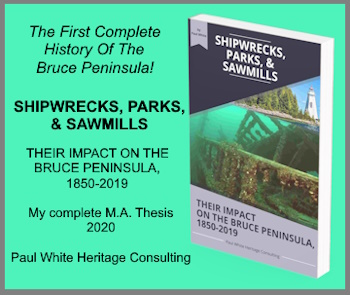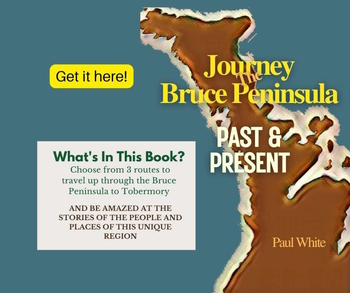Bruce Peninsula
Lumber History
Bruce Peninsula lumber history details the impact of forest products on the development of the region.
Every winter outdoor enthusiasts head to the Bruce Peninsula to enjoy winter sports such as cross-country skiing, snowmobiling, ice fishing, and for the truly hardy, winter camping. During the early days of settlement in this area winter was also a time of great activity in the hinterlands of the peninsula.
Researching the Bruce Peninsula's lumber history illustrates that the large stands of timber attracted entrepreneurs to the area and local settlers augmented their income as lumberjacks and sawmillers. One of the first sawmills erected in the area was on the Sauble River. From this inaugural enterprise more than thirty sawmills of various sizes were built in the hinterlands of the peninsula. However, the hub of the timber industry was probably the Wiarton area. The lower end of Colpoys Bay at one time was the home for eight large sawmills. Wiarton’s position in this industry was further enhanced by the fact that most of the forest products harvested in the area were shipped to market through the rail and water terminals located there.
The opening of the Bruce Peninsula forest products industry was a natural progression in the evolution of that industry in Canada. At first it was the Ottawa Valley that was the focus of the lumberman’s axe. As the forests in that region were depleted of their supply of quality forest products the lumbering interests moved west and north into the French River region. As western Ontario, the prairies, and the American Midwest opened to further settlement there was a need for easily accessible timber products. Although the French River lumber interests were able to satisfy some of this market demand it was thought that the forests of Georgian Bay's north shore and the Bruce Peninsula were more strategically located to service the demands of the new markets. As well, the demand for land for settlement necessitated the clearing of areas such as the Bruce Peninsula. Consequently, companies raced to harvest the forests to reap the profits which might otherwise have disappeared in the smoke of the fires set by settlers to clear their land of the unwanted timber.
One major product taken from the Bruce Peninsula forests was the bark from hemlock trees. On average about 4,000 cords of hemlock were shipped annually to tanneries in Kitchener, Acton, Listowel, and Toronto.
The abundance of cedar in the area provided another huge source of revenue for area mills. It was estimated that 300,000 railway ties were produced each year and shipped to market by train. Early settlers remember twenty-five carloads of ties and other forest products chugging out of the Wiarton railway station each day during the summer months. The train loads were increased by the fact that sawmills on Manitoulin Island shipped their produce to Wiarton to be loaded onto rail cars.
Most of the logs arriving in Wiarton, or at the other area sawmills arrived in massive floating booms. However, not all of the logs cut on the Bruce Peninsula were sawn at area mills. Frequently, many of the smaller booms were formed into larger booms towed by large vessels to mills in larger market areas. Some area log booms were towed as far away as Chicago and Green Bay.
One of the largest contracts ever let to a Bruce Peninsula lumber company occurred in1891 when Seaman and Newman, a Wiarton area sawmill was contracted to supply 500,000 square feet of 25 to 30-foot hemlock timber for construction at the Sault Ste. Marie locks. The hemlock was built into large cribs which were 25 feet wide, 150 feet long and 13 feet and towed by tugs to the Sault.
The canal builders were so happy with the product and service provided by the company that during the next six years they purchased more six million feet of Bruce Peninsula hemlock. During the entire operation only one timber boom was lost. This in itself is an amazing feat considering that the timber had to travel through the hazardous waters around Tobermory and the North Shore channel.
Bruce Peninsula lumber is no longer a major economic force, but it provided the impetus to settle the region. Today the remaining forests of the area ring with sounds other than that of the axe and the saw. Snowmobiling, skiing, fishing, and other recreational activities have become the new basis for the economy for the region.
The information used in this article came from many sources. However, primary use was made of “Wiarton’s Eight Busy Mills were Centre of Industry in the Bruce Peninsula” by W. M. Newman.
A version of this article originally appeared in my Local History column in the Owen Sound Sun Times in 1998. If you are looking for more information about the history of the Bruce Peninsula, my latest book Journey the Bruce Peninsula Past & Present makes a great travel companion as you travel this unique part of Canada's Great Lakes region.
Discover More About the Bruce Peninsula
Getting to the Bruce Peninsula is a relatively easy driving trip. Here are driving directions from three regions to the peninsula.
Bruce Peninsula Lumber History details the impact of the forest products industry on the development of the region.
Bruce Peninsula Lumbering provided the stimulus to develop and grow the pioneer economy on the newly settled Bruce Peninsula.
Bruce Peninsula Municipal Politics: No matter what the venue, or the issue, seldom is a popular decision made that suits everyone.
Bruce Peninsula Travel Routes were often a matter of debate because in the early years, land travel was virtually unattainable for settlers and lumbermen alike.
Bruce Peninsula winters could be difficult, especially in pioneer times when transportation connections were limited to only a few months each year.
Colpoys Bay Vista - Awesome! A short drive from either Wiarton or Owen Sound is one of the most magnificent views to be found in the province of Ontario!
Forest Products on the Bruce Peninsula contributed greatly to the growth and development of that region of the province of Ontario.
Gillies Lake: aka Ghost Lake has a mysterious past as its original name, Ghost Lake, implies.
Great Grey Owls on the Bruce Peninsula was a surprise discovery for ornithologists and others. Sadly, the story of their visit had an unfortunate conclusion.
Pioneer Campers: Hope Bay mostly considered the peninsula untamed wilderness and some of the locals were not about to disappoint them!
Pioneer Missionary James Atkey arrived on Colpoys Bay to minister to the native community near Oxenden until a treaty uprooted his parishioners.
Pioneer tourists first visited the Bruce Peninsula in the 1800s and the region continues as a great recreational and tourism destination today!
Pioneer Vacations on the Bruce Peninsula got an eerie start in the Hope Bay region of the peninsula.
Lighthouses Lighthouses were vital to Georgian Bay Sailing.
A Flowerpot Island cruise is not only entertaining, but it is also very educational as you will see things that you have never viewed before!
Travel the Bruce: Owen Sound to Wiarton A wonderful journey from Owen Sound to Wiarton.
Travel the Bruce: Wiarton to Tobermory Relaxing and historic journey.
Bruce Peninsula The Bruce Peninsula is a compelling place, with a rich history, to visit. Once you have traveled there, we guarantee that you will return, again and again!






